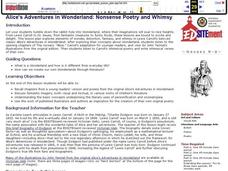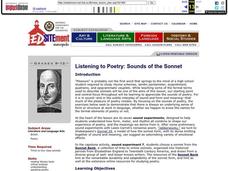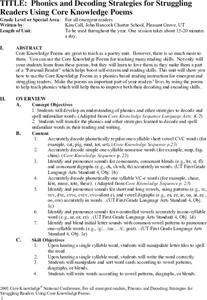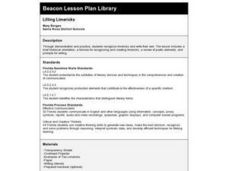Curated OER
Edward Lear, Limericks, and Nonsense
Introduce your class to the delights of nonsense poetry and explore literary devices with the writing of Edward Lear. Learners identify rhyme and meter as well as figures of speech, alliteration, and onomatopoeia in "The Owl and the...
Curated OER
Short Poems Are Scary!
What do all those chairs and pencils do in the classroom once everyone leaves? Allow imaginations to run wild with frighteningly short poems!
DLTK
Writing Limericks
Scholars are lucky to stretch their poetry writing muscles with a worksheet that challenges them to compose two limericks—one about a boy and the other about a dog.
Curated OER
Edward Lear, Limericks, and Nonsense: There Once Was...
Students recognize poetic devices including rhyme, syllabification, and meter. They identify the characteristics of a nonsense poem and of a limerick. They write their own limericks.
Poetry Society
The Jumblies
Who would ever think to go to sea in a sieve? Only Edward Lear's Jumblies! The poem "The Jumblies" is the inspiration for these poetry reading and writing activities that ask learners to think about how strangers are different, consider...
Poetry4kids
How to Write a Traditional “Mother Goose” Nursery Rhyme
There may be some little lambs, itsy bitsy spiders, and pumpkin eaters in your language arts class! An online poetry lesson takes learners through the steps of writing a nursery rhyme with easy-to-follow steps and explanatory examples.
Curated OER
Alice's Adventures in Wonderland: Nonsense Poetry and Whimsy
Primary learners are introduced to Lewis Carroll's whimsical poetry. They read "The Nursery Alice" Carroll's adaptation for younger readers, view story illustrations, listen to poetry and write whimsical verses of their own about food.
Curated OER
Edward Lear, Limericks, and Nonsense: There Once Was?
Students explore limericks. In this poetry writing lesson, students listen to and read a variety of poems written by Edward Lear. Students count syllables and identify meter by clapping as they read aloud. Students complete a limerick...
Curated OER
Write Your Own Poem: Rhyming Word Pattern -end, -ind, -and
For this rhyming verse worksheet, students read 20 words in a chart and color them according to the directions, using a different color for each ending rhyme pattern. Students then answer 10 questions in which they write simple nonsense...
Curated OER
Listening to Poetry: Sounds of the Sonnet
Learners investigate how sound influences meaning in poetry by listening to sonnets. They write an analysis after listening to and reading sonnets.
Curated OER
Nonsense Knows
For this poetry lesson, young readers discuss that poems can sometimes have silly words and made up people, places, and things. Students read and listen to silly poems then write a response poem to their favorite.
Bright Hub Education
Jabberwocky - A Creative Writing Lesson Plan
Make some sense out of Lewis Carroll's famous nonsense poem "Jabberwocky." After reading through the poem, introduce the word portmanteau and send small groups off to alter the original poem.
Curated OER
Write Your Own Poem 'ap'
In this rhyming words worksheet, students complete four activities that help them learn rhyming words containing 'ap.' Students color words that rhyme with cap, pair the rhyming words, make silly sentence with the words and a nonsense poem.
Houston Teachers Institute
Alice in Wonderland: Nonsense and Logic in Literature
Alice's Adventures in Wonderland is known for its fantastical imagery and nonsense verse. This unit plan offers a basic exploration into nonsense verse through poetry and teacher read-alouds. It incorporates activities involving poetry...
Curated OER
Listening to Poetry: Sounds of the Sonnet
High schoolers experience and enjoy the sounds of poetry. They erform sound experiments with sonnets and closely read and analyze a sonnet by Shakespeare. Students write an analysis of how sound affects meaning in a sonnet chosen from...
K12 Reader
Jabberwocky
Readers demonstrate their ability to use word endings and word relationships to identify the parts of speech of the nonsense words in Lewis Carroll's "Jabberwocky."
Curated OER
Phonics and Decoding Strategies for Struggling Readers Using Core Knowledge Poem
Students complete multiple activities to help them hear sounds, syllables, and spell words with vowel patterns, digraphs, or blends. In this word sounds lesson, students use letter tiles, sort words cards, analyze poems, and play a bingo...
Curated OER
"Jabberwocky": Inferring
Pupils, over an extended time, read and explain the nonsense words of Lewis Carroll's poem, "Jabberwocky". They infer the meaning of the poem using visualizing as well as decoding skills. While written for first graders, this is easily...
Curated OER
"Quack Said the Billy-goat"
Second graders read the poem together, "Quack Said the Billy-goat" and discuss what makes the poem funny and which words rhyme. They observe the teacher writing a new first verse, changing some of the text, but leaving the original rhyme...
Curated OER
Lilting Limericks
Students discover the formula for writing limericks and use it to write their own poems.
Curated OER
Jabberwocky Lesson Plan
Students complete a review of the parts of speech using a jabberwocky poem format. In this parts of speech and poetry instructional activity, students read a jabberwocky poem and identify parts of speech in the poem. Students list...
Curated OER
The Pied Piper Of Hamelin
Students participate in a lesson that covers the genre of narrative poetry. They examine the elements of a narrative poem while focusing upon the characterization. Students compare and contrast the characters while analyzing their...
Pearson
Rumpelstiltskin
Classic fairy tales are great! They have memorable characters, present interesting story lines, and lend themselves to art projects. Grab a copy of "Rumpelstiltskin" and get ready to participate in several early literacy activities. The...
Curated OER
Tongue Twisters
Second graders read the poem, "Betty Botter" and give their opinion of it. They discover what a tongue twister is and read the poem out loud together. Then as a class they read "Peter Piper" and discuss the similarities of the two poems.

























